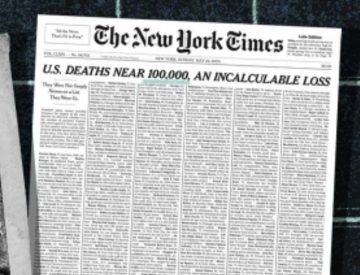Rebecca Onion in Slate:
 At first, some believed the numbers of Americans dead of the coronavirus might stay in the five figures. Then, as the toll climbed into six, some grieved, some grew numb, some made comparisons to the numbers lost in wars, some threw up every possible defense to deny that these numbers mattered. How is it that so many deaths—194,000 in the U.S. as of this weekend’s official count—can feel so intangible, so hard for so many people to fathom?
At first, some believed the numbers of Americans dead of the coronavirus might stay in the five figures. Then, as the toll climbed into six, some grieved, some grew numb, some made comparisons to the numbers lost in wars, some threw up every possible defense to deny that these numbers mattered. How is it that so many deaths—194,000 in the U.S. as of this weekend’s official count—can feel so intangible, so hard for so many people to fathom?
Jacqueline Wernimont, a historian who writes about quantification and commemoration, has been watching this unfold and feeling no small sense of déjà vu. Wernimont’s book, Numbered Lives: Life and Death in Quantum Media, is a history of the way we came to quantify mass death—and how those numbers have, too often, blunted the pain of those deaths. We spoke recently about the blurry historical line between “bills of mortality” in plague times and COVID dashboards, and why numbers can make some people feel, and others stop feeling. Our conversation has been condensed and edited for clarity.
Rebecca Onion: In your book, you point to the bills of mortality, which publicized the numbers of dead during 17th century plague epidemics in London, as a first instance of media that people in the middle of an outbreak could use to keep up with death counts. What were the bills of mortality, for the unfamiliar?
Jacqueline Wernimont: The bills were publications, but also internal government documents. They were often published as broadsides—longer pieces of paper that could be nailed to poles or put in taverns or, say, at the entrance of London Bridge. They were sold as a single sheet for about 2 pence in the market and were compiled by what was known as the “Worshipful Company of Parish Clerks,” an incorporated group that had a royal warrant to gather information about people who had died and to publish and sell it.
The practice of gathering deaths and birth information had been going on for a long time, back to the medieval period, but around this time the tradition shifted.
More here.
